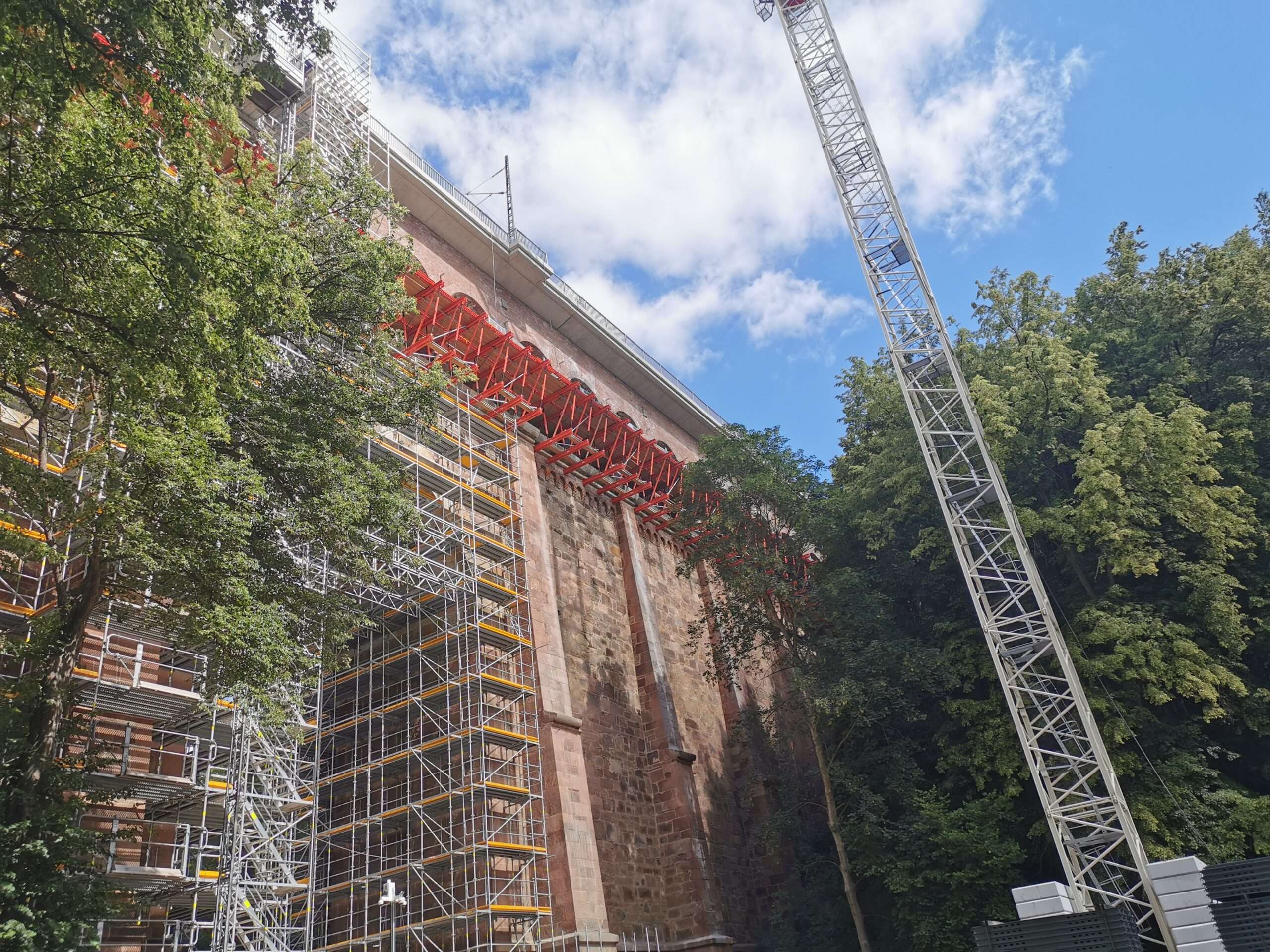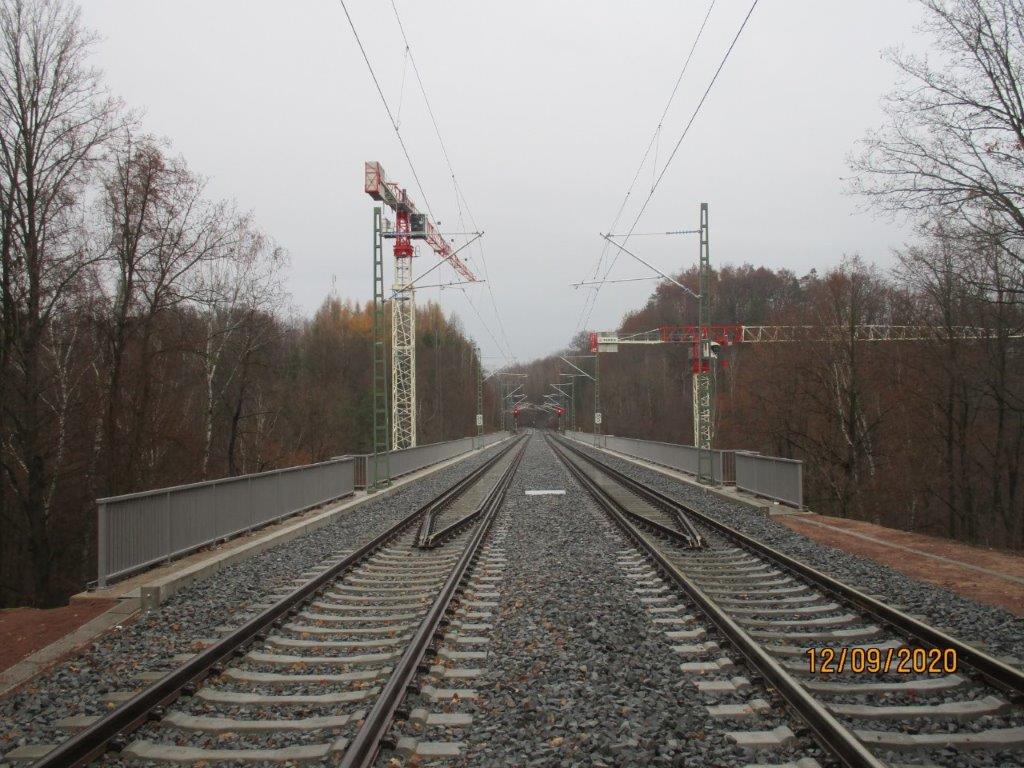Successful commissioning of the Heiligenborn Viaduct in Saxony, Germany
Just in time for the new timetable in December 2020, the railway viaduct in Heiligenborn and the two transferred tracks of the Riesa – Chemnitz line between Waldheim and Mittweida in Saxony were successfully put into operation after almost five years of demanding planning and construction.

The listed arched bridge, “Heiligenborn Viaduct”, in Waldheim, built in 1852 on the route between Riesa and Chemnitz, was comprehensively renovated and restored over a planning and construction period of only five years. The historic railway viaduct is an extremely imposing structure. There are 36 smaller arches on the 12 piers of the stone arch viaduct. The vault masonry and the bridge piers are made of natural stones and bricks.
On behalf of DB Netz AG, DB Engineering & Consulting was responsible for the entire construction management, from planning and construction to completion of the overall measures. Further planning services such as the final design, planning for building permit application, request for proposal planning, geotechnical and environmental expert opinions, as well as construction supervision services and waste disposal were provided under the lead management of DB Engineering & Consulting’s Southeast Region in Germany.
Construction measures at a glance
Construction work on the 170-meter-long and 40-meter-high railroad viaduct began in spring 2019. The partial replacement construction (new roadway trough) was carried out in 2 construction states starting in October 2019, each with a one-sided line closure lasting several months.
The signaling requirements for these construction states in the line area between Waldheim and Mittweida had not been met until then.
In order to be able to carry out the construction, it was therefore necessary to perform extensive planning and construction work of the control-command and signaling equipment in the Waldheim and Mittweida signal boxes and of the underground cable installation in the 15-km-long section of the line. A total of approx. 28 kilometers of cable, 34 kilometers of switching wire, 23 relay groups and 851 relays were installed in the outdoor installation, and approx. 7,000 meters of cable trough were erected.
In two construction stages, the existing brick roadway trough was demolished for each sorting siding and replaced with a new reinforced concrete roadway trough that complies with the regulations. Parallel to this, a complete renovation of the structure was carried out. Here, too, various planning and construction measures were required for implementation of the work on the overhead line equipment, permanent way, train protection system and cable systems.
The construction of the shoring and working scaffolds for the activities at a height of 40 meters was complicated – a foundation in the slope areas was not possible due to instability and the scaffold had to be adapted to the different vault geometries.
 Construction of Heiligenborn Viaduct in Saxony, Germany
Construction of Heiligenborn Viaduct in Saxony, GermanyConstruction of Heiligenborn Viaduct in Saxony, Germany  Construction of roadway trough
Construction of roadway troughConstruction of roadway trough  Construction of abutments Mittweida
Construction of abutments MittweidaConstruction of abutments Mittweida  View in the direction of Waldheim
View in the direction of WaldheimView in the direction of Waldheim
Challenging construction
The greatest construction challenges were encountered in the existing structure in the following areas:
- Control-command and signaling equipment: The work in the Mittweida and Waldheim signal boxes was challenging. 6,335 design documents had to be planned, checked and implemented structurally within the specified time period (short total closures).
- Structural engineering: Immediately after shoring began to be placed in the safety area of the tracks, significant difficulties were encountered at both abutments. The planned shoring was not feasible. A new shoring construction (bored pile wall) had to be implemented in the shortest possible time in terms of operations (additional closures, temporary railroad crossing), planning and engineering. This was achieved through the excellent teamwork of all those involved. In the area of the abutments, fillings were found that most probably originated from the nearby quarry/cut [tunnel]. Considerable replanning was necessary here.
In order to protect protected species, such as the sand lizard, elaborate replacement habitats as well as extensive compensation and replacement plantings were created for nature and landscape conservation.
In 2021, remaining work such as scaffolding (dismantling), restoration of used site facility areas, disposal of spoil, construction of the inner access to the bridge and the outer connection of the drainage will be executed.
Contact
DB Engineering & Consulting
EUREF-Campus 14
10829 Berlin
Germany





